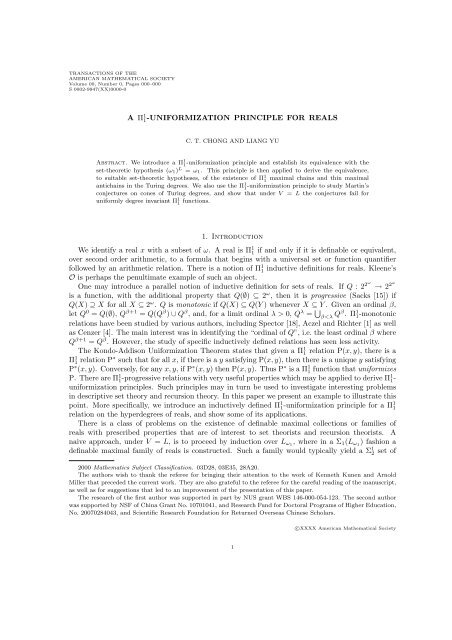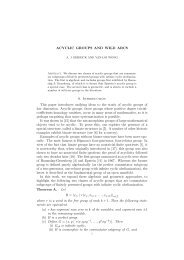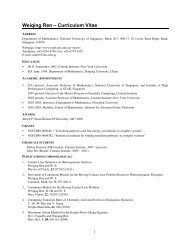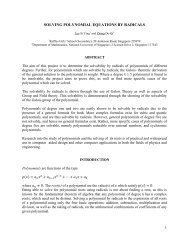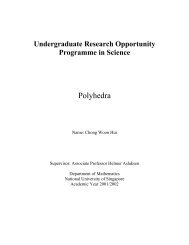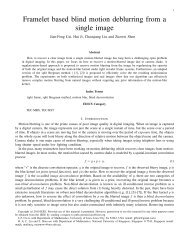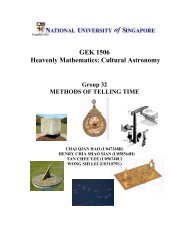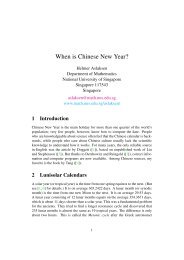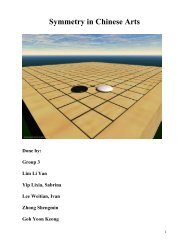17. C. T. Chong and Liang Yu, A$\Pi^1_1$ uniformization principle ...
17. C. T. Chong and Liang Yu, A$\Pi^1_1$ uniformization principle ...
17. C. T. Chong and Liang Yu, A$\Pi^1_1$ uniformization principle ...
You also want an ePaper? Increase the reach of your titles
YUMPU automatically turns print PDFs into web optimized ePapers that Google loves.
TRANSACTIONS OF THE<br />
AMERICAN MATHEMATICAL SOCIETY<br />
Volume 00, Number 0, Pages 000–000<br />
S 0002-9947(XX)0000-0<br />
A Π 1 1-UNIFORMIZATION PRINCIPLE FOR REALS<br />
C. T. CHONG AND LIANG YU<br />
Abstract. We introduce a Π1 1-<strong>uniformization</strong> <strong>principle</strong> <strong>and</strong> establish its equivalence with the<br />
set-theoretic hypothesis (ω1) L = ω1. This <strong>principle</strong> is then applied to derive the equivalence,<br />
to suitable set-theoretic hypotheses, of the existence of Π1 1 maximal chains <strong>and</strong> thin maximal<br />
antichains in the Turing degrees. We also use the Π1 1-<strong>uniformization</strong> <strong>principle</strong> to study Martin’s<br />
conjectures on cones of Turing degrees, <strong>and</strong> show that under V = L the conjectures fail for<br />
uniformly degree invariant Π1 1 functions.<br />
1. Introduction<br />
We identify a real x with a subset of ω. A real is Π1 1 if <strong>and</strong> only if it is definable or equivalent,<br />
over second order arithmetic, to a formula that begins with a universal set or function quantifier<br />
followed by an arithmetic relation. There is a notion of Π1 1 inductive definitions for reals. Kleene’s<br />
O is perhaps the penultimate example of such an object.<br />
One may introduce a parallel notion of inductive definition for sets of reals. If Q : 2 2ω<br />
→ 2 2ω<br />
is a function, with the additional property that Q(∅) ⊆ 2 ω , then it is progressive (Sacks [15]) if<br />
Q(X) ⊇ X for all X ⊆ 2 ω . Q is monotonic if Q(X) ⊆ Q(Y ) whenever X ⊆ Y . Given an ordinal β,<br />
let Q 0 = Q(∅), Q β+1 = Q(Q β ) ∪ Q β , <strong>and</strong>, for a limit ordinal λ > 0, Q λ = <br />
β
2 C. T. CHONG AND LIANG YU<br />
reals over second order arithmetic. Much harder work is required if one aims for a collection of lower<br />
complexity. Refining the naive construction, Kunen <strong>and</strong> Miller [13] have obtained a Π 1 1 maximal<br />
family of almost disjoint sets. In [5] <strong>and</strong> [6], we investigated the problem of the existence of Π 1 1<br />
maximal chains <strong>and</strong> thin (i.e. without a perfect subset) antichains in the Turing degrees, <strong>and</strong> proved<br />
the equivalence of the existence of these sets with respective set theoretic hypotheses on ω1 <strong>and</strong><br />
2 ω . Underlying the constructions were similar techniques <strong>and</strong> intuitions that pointed to a general<br />
<strong>principle</strong> applicable to different situations, perhaps at a deeper level. Our investigation leads to the<br />
formulation of a Π 1 1-<strong>uniformization</strong> <strong>principle</strong>, denoted I, discussed below. The <strong>principle</strong> is applied<br />
to establish the key results in [5] <strong>and</strong> [6], <strong>and</strong> also to study Martin’s conjectures on Turing degrees.<br />
It is worth noting that the idea of coding reals in the formulation of the <strong>principle</strong> I was also used<br />
in the work of Kunen <strong>and</strong> Miller to construct Π 1 1 maximal family of almost disjoint sets.<br />
Let C be the set of reals x such that x ∈ Lω x 1 , where as usual ωx 1 is the least admissible ordinal<br />
not recursive in x. It is well known that C is Π 1 1 <strong>and</strong> that every Π 1 1 set of reals contains an element<br />
of C (Sacks [15]). Elements of C enjoy special properties that are not available to those in its<br />
complement. For example, if x is a master code in the sense of Jensen’s fine structure theory [10]<br />
(or equivalently an “arithmetical copy” in the sense of Boolos <strong>and</strong> Putnam [3]), then x ∈ C. In [5]<br />
<strong>and</strong> [6], the Π 1 1 maximal chain <strong>and</strong> thin antichain were constructed exploiting this fact, so that each<br />
element of these sets was chosen to be in C with specific properties, including requiring it to have<br />
double Turing jump that is Turing equivalent to a master code. However, the double jump, while<br />
sufficient for the constructions of the sets in [5] <strong>and</strong> [6], is probably too restrictive <strong>and</strong> not necessary<br />
for a deeper underst<strong>and</strong>ing of the “Π 1 1 phenomenon”, <strong>and</strong> the use of fine structure theory as well as<br />
Borel determinacy, while interesting <strong>and</strong> revealing, might also be avoided when viewed in a different<br />
light. This is the intuition behind our search for a general <strong>principle</strong>. The motivation is that the<br />
<strong>principle</strong> should not only prove theorems obtained in [5] <strong>and</strong> [6], but also be useful for studying<br />
other problems. The test problem we consider is Martin’s conjectures on cones of Turing degrees<br />
for degree invariant functions. Since this is known to be false under AC, <strong>and</strong> the conjectures are<br />
posed under the assumption of the Axiom of Determinacy AD, <strong>and</strong> known to hold for uniformly<br />
degree invariant functions assuming AD (Steel [19], Slaman <strong>and</strong> Steel [16]), we focus our attention<br />
on uniformly definable degree invariant functions—in this case Π 1 1—to learn how far AC <strong>and</strong> the<br />
conjectures may co-exist in a model of set theory without full AD.<br />
The organization of the paper is as follows. In §2 we recall some st<strong>and</strong>ard notions, definitions<br />
<strong>and</strong> results in hyperarithmetic theory, highlighting in particular the Spector-G<strong>and</strong>y Theorem which<br />
characterizes Π 1 1 sets of reals. In §3 we introduce a Π 1 1-progressive relation <strong>and</strong> use it to define<br />
the Π 1 1-<strong>uniformization</strong> <strong>principle</strong> I. We show the validity of this <strong>principle</strong> under the set-theoretic<br />
hypothesis (ω1) L = ω1, <strong>and</strong> demonstrate that I <strong>and</strong> the hypothesis are equivalent. In §4 we show<br />
that the existence of a Π 1 1 maximal chain <strong>and</strong> a thin Π 1 1 maximal antichain is a consequence of, <strong>and</strong><br />
equivalent to, I under appropriate set-theoretic axioms. In §5 we apply the <strong>uniformization</strong> <strong>principle</strong><br />
to study Martin’s conjectures, <strong>and</strong> show that it fails with Π 1 1 degree invariant functions under V = L.<br />
In particular, we exhibit Π 1 1 uniform degree invariant functions f on the reals such that f(x) ≡T x<br />
on cofinally (in the sense of Turing reducibility) many x’s but f(x) is not Turing equivalent to x on<br />
any cone of Turing degrees. Our final result states that
A Π 1<br />
1-UNIFORMIZATION PRINCIPLE FOR REALS 3<br />
2. preliminaries<br />
We adopt set-theoretic notations throughout this paper. In particular, small Roman letters<br />
x, y, z, . . . refer to reals, while Greek letters α, β, . . . denote ordinals. The collection of paths of a<br />
perfect tree T is denoted [T ], <strong>and</strong> 〈〉 is a recursive bijection from ω × ω to ω. Finally,
4 C. T. CHONG AND LIANG YU<br />
3. A Π 1 1-Uniformization <strong>principle</strong><br />
Definition 3.1. A binary relation P(x, y) on 2 ω × 2 ω is cofinally progressive if for every real x, the<br />
set {y|P (x, y)} is cofinal in the hyperdegrees, i.e. for each z, there is a real y ≥h z such that P(x, y)<br />
holds.<br />
Lemma 3.2. Assume (2 ω ) L = 2 ω . If a Π 1 1 relation P is cofinally progressive, then for every real x<br />
<strong>and</strong> z there is a real y ≥h z such that y ∈ C <strong>and</strong> P(x, y).<br />
Proof. Suppose (2 ω ) L = 2 ω <strong>and</strong> P is cofinally progressive. Then for any reals x, z, the set A = {y |<br />
x ⊕ z ∈ L ω y<br />
1 ∧ P(x, y)} is a non-empty Π1 1(x ⊕ z) set. Thus, by Proposition 2.2 , there is a real y ∈ A<br />
for which y ∈ L ω (x,z,y)<br />
1<br />
y ∈ L ω (x,z,y)<br />
1<br />
[x ⊕ z] = L ω y<br />
1<br />
[x ⊕ z]. Since x ⊕ z ∈ L y<br />
ω1 , we have x ⊕ z ≤h y <strong>and</strong> so ω (x,z,y)<br />
1<br />
= ω y<br />
1 . Then<br />
<strong>and</strong> P(x, y). <br />
Given a countable set A <strong>and</strong> a real x, we say that x codes A if {(x)n|n ∈ ω} = A where<br />
(x)n = {m|m ∈ ω ∧ 〈n, m〉 ∈ x}.<br />
A cofinally progressive relation generates a progressive relation (in the sense defined in §1) as<br />
follows: Let P (x, y) be cofinally progressive. For each X ⊆ 2 ω , let Q(X) = X ∪ {y|∃x ∈ XP (x, y)}.<br />
Then it is immediate that Q(X) ⊇ X for all X. However, an operation such as Q may be too general<br />
to be useful <strong>and</strong> this motivates a refinement of Q to something close to a <strong>uniformization</strong> function for<br />
well-defined sets. Now if P (x, y) is Π 1 1, the Kondo-Addison Theorem guarantees a <strong>uniformization</strong><br />
function for P . However, our interest is in strong <strong>uniformization</strong>, i.e. a function that uniformizes<br />
“initial segments of reals” that does roughly the following: If x codes a set of reals in C such that<br />
any two elements w
A Π 1<br />
1-UNIFORMIZATION PRINCIPLE FOR REALS 5<br />
(5) If (t, y, µ) γ ′ so that (Lβ+1 \ Lβ) ∩ 2ω = ∅ <strong>and</strong> a<br />
real z ∈ Lβ+1 \Lβ so that x⊕z ∈ Lωz 1 <strong>and</strong> Lγ |= ψ(x, z, s) for some limit ordinal γ < ωz 1 <strong>and</strong> s ∈ Lγ.<br />
[X, z] <strong>and</strong> Lγ = Lγ[X, z] for all sufficiently large γ < ωz 1. So (1)—(3) are<br />
Note that Lω z 1 = L ω (X,z)<br />
1<br />
satisfied. Obviously we can assume that (s, z, γ) is the
6 C. T. CHONG AND LIANG YU<br />
For (ii): If y ∈ A then y = G(α) for some α < ω1. By the definition of G, there is a real<br />
x ∈ L G(α) such that x codes the set {G(β)|β < α} <strong>and</strong> P(x, G(α)) holds. But obviously β < α if<br />
ω1 <strong>and</strong> only if G(β)
A Π 1<br />
1-UNIFORMIZATION PRINCIPLE FOR REALS 7<br />
4. Maximal chains <strong>and</strong> thin maximal antichains in the Turing degrees<br />
In this section, we apply the <strong>uniformization</strong> <strong>principle</strong> I to solve the existence problem of Π 1 1<br />
maximal chains <strong>and</strong> thin Π 1 1 maximal antichains in the Turing degrees. These problems were studied<br />
in [5] <strong>and</strong> [6] using direct constructions involving the Boolos-Putnam analysis of constructible reals.<br />
Here we derive the results from the <strong>principle</strong> I.<br />
Theorem 4.1 (<strong>Chong</strong> <strong>and</strong> <strong>Yu</strong> [5]). Assume (ω1) L = ω1. There is a Π 1 1 maximal chain in the<br />
Turing degrees.<br />
Proof. Define a binary relation P as follows:<br />
P(x, y) ⇔ y is a minimal cover of {(x)n|n ∈ ω}.<br />
It was shown in [5] that P is a ∆ 1 1 cofinally progressive relation (in the language of the current<br />
paper). Hence by Theorem 3.4, there is a Π 1 1 set A as prescribed. I(ii) implies that A is a maximal<br />
chain. <br />
In the case of a maximal antichain, a diagonal argument shows that under ZF C there is a thin<br />
maximal antichain in the Turing degrees. Hence the definability of a thin set with such a property<br />
becomes particularly interesting. Since every set of reals whose degrees form a maximal antichain<br />
has size 2 ℵ0 , it cannot be Σ 1 1 (else it would contain a perfect subset). The next level of definability<br />
is then Π 1 1. We apply Theorem 3.4 to construct a thin Π 1 1 maximal antichain in the Turing degrees.<br />
Theorem 4.2. Assume (2 ω ) L = 2 ω . There exists a Π 1 1 thin maximal antichain in the Turing<br />
degrees.<br />
Proof. Define a binary relation P(x, y) as follows:<br />
(1) {(x)n|n ∈ ω} 1 is not an antichain or;<br />
(2) {(x)n|n ∈ ω} ∪ {y} is an antichain <strong>and</strong><br />
(2a) x ⊕ (y)0 ∈ L y<br />
ω1 ;<br />
(2b) {(x)n|n ∈ ω} ∪ {(y)0} is an antichain;<br />
(2c) for every z
8 C. T. CHONG AND LIANG YU<br />
Theorem 4.3. (ZFC)<br />
(i) There is a thin Π 1 1 maximal antichain of Turing degrees if <strong>and</strong> only if (2 ω ) L = 2 ω .<br />
(ii) There is a thin Π 1 1 (boldface) maximal antichain of Turing degrees if <strong>and</strong> only if (2 ω ) L[x] = 2 ω<br />
for some real x.<br />
Proof. (i): Suppose A is a thin Π 1 1 maximal antichain. Then by Theorem 2.3, A ⊂ L. Now<br />
let x be a real. By a theorem of Cooper [7], there is a real y of minimal degree such that<br />
x ≤T y ′ . Since A is a maximal antichain, there is a real z ∈ A with z ≥T y. So x ≤T z ′ .<br />
Hence x ∈ L.<br />
Conversely, suppose (2 ω ) L = 2 ω . Fix a Π 1 1 set G as in Lemma 4.2. Since the statement<br />
“G is an antichain in the Turing degrees” is Π 1 2 <strong>and</strong><br />
L |= “G is an antichain in the Turing degrees”,<br />
G is an antichain in the Turing degrees in V by absoluteness. Fix a real x. Since (2 ω ) L = 2 ω ,<br />
x ∈ L. The statement T (x) :“there exists y ∈ G so that y is Turing comparable with x” is<br />
Σ 1 2(x) <strong>and</strong> L |= T (x). It follows that T (x) is true. Thus G is a maximal antichain.<br />
(ii): Relativize the proof of (i).<br />
<br />
A direct proof of Theorem 4.3 may be found in [6]. It follows that to construct a model in which<br />
there is no thin Π 1 1 maximal antichain of Turing degrees, one only needs to refute CH in the model.<br />
Theorem 3.4 explains why additional hypothesis is required to show Theorem 4.2, even with help<br />
from the <strong>uniformization</strong> <strong>principle</strong> I, since the assumption (ω1) L = ω1 is not sufficient to construct<br />
a Π 1 1 thin maximal antichain. Nevertheless, the following theorem still holds:<br />
Proposition 4.4. If (ω1) L = ω1, then there is a Π 1 1 thin antichain of size ℵ1 in the Turing degrees.<br />
Proof. Define a binary relation P(x, y):<br />
(1) ({(x)n|n ∈ ω} is not an antichain, or<br />
(2) {(x)n|n ∈ ω} ∪ {y} is an antichain.<br />
Obviously P(x, y) is ∆ 1 1 <strong>and</strong> cofinally progressive. By Theorem 3.4, there is a Π 1 1 set A as described<br />
in the <strong>uniformization</strong> <strong>principle</strong>. One verifies that A is an antichain of size ℵ1. <br />
It should be pointed out that a number of results concerning Π 1 1-ness—for example those considered<br />
in [13]—may be derived from Theorem 3.4. On the other h<strong>and</strong>, the existence of Π 1 1 maximal<br />
chains <strong>and</strong> antichains does not extend to all notions of reducibility. For example, there is no Π 1 1 set<br />
of reals whose hyperdegrees form a maximal chain. To see this, suppose that A is such a set. Then<br />
A does not contain a perfect subset since otherwise there will be two paths having incomparable<br />
hyperdegrees. By Theorem 2.3 of Mansfield <strong>and</strong> Solovay, this implies that A ⊂ C. Let α be count-<br />
able admissible that is also a limit of an increasing sequence of admissible ordinals {α xn<br />
n |n < ω}<br />
with xn ∈ A. Then there is a real x such that ωx 1 = α [14]. By the choice of α, x /∈ C <strong>and</strong> therefore<br />
x /∈ A. However, xn
A Π 1<br />
1-UNIFORMIZATION PRINCIPLE FOR REALS 9<br />
5. Martin’s conjectures <strong>and</strong> I<br />
In this section, we apply Theorem 3.4 to study Martin’s conjectures under the assumption V = L.<br />
We begin by recalling some definitions.<br />
Let f : 2 ω → 2 ω .<br />
Definition 5.1. (1) f is degree invariant if <strong>and</strong> only if ∀x∀y(x ≡T y =⇒ f(x) ≡T f(y)).<br />
(2) f is uniformly degree invariant if <strong>and</strong> only if there is a function t : ω → ω such that for all<br />
i, j < ω <strong>and</strong> reals x <strong>and</strong> y, x = Φ y<br />
i ∧ y = Φxj ∧ f(y) = Φf(x)<br />
(t(〈i,j〉)1 .<br />
=⇒ f(x) = Φf(y)<br />
(t(〈i,j〉))0<br />
(3) f is increasing on a cone if <strong>and</strong> only if there is a real y such that for all x ≥T y, x ≤T f(x).<br />
(4) f is order preserving on a cone if <strong>and</strong> only if there is a real y such that for all x, z ≥T y,<br />
x ≤T z =⇒ f(x) ≤T f(z).<br />
(5) f is constant on a cone if <strong>and</strong> only if there are reals y <strong>and</strong> y0 such that for all x ≥T y,<br />
f(x) ≡T y0.<br />
Given degree invariant functions f <strong>and</strong> g, write f ≥M g if f(x) ≥T g(x) on a cone. Martin’s<br />
conjectures state that assuming ZF together with AD <strong>and</strong> Axiom of Dependent Choice (DC),<br />
(I) Every degree invariant function f that is not increasing on a cone is constant on a cone; <strong>and</strong><br />
(II)
10 C. T. CHONG AND LIANG YU<br />
Roughly speaking, y is the
(a) z ∈ A;<br />
(b) z ≥T x;<br />
(c) y = W z n+1;<br />
(d) x >T ∅ =⇒ ∀m(x ≤T ((z)0)m).<br />
A Π 1<br />
1-UNIFORMIZATION PRINCIPLE FOR REALS 11<br />
Roughly speaking, y is the W z n+1 for the
12 C. T. CHONG AND LIANG YU<br />
Department of Mathematics, Faculty of Science, National University of Singapore, Lower Kent Ridge<br />
Road, Singapore 117543<br />
E-mail address: chongct@math.nus.eud.sg<br />
Institute of Mathematical Sciences, Nanjing University, Nanjing, Jiangsu Province 210093, P. R. of<br />
China<br />
E-mail address: yuliang.nju@gmail.com


